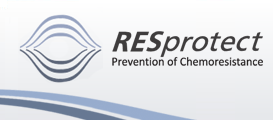|
Page 4 of 12
Treatment of AH13r Sarcomas in SD-Rats.
Ten SD-rats per treatment group were given a single s.c. injection of ascites Yoshida AH13r hepatoma cells. Five to 7 days after tumor application, the growth of the resulting tumors (at the injection site) was suppressed by i.p. treatment of the animals with 2 or 4 mg/kg DOX (9 times within 3 weeks), 120 or 140 mg/kg glufosfamide (15 times within 3 weeks), and 0.5 or 1.5 mg/kg cisplatin only (4 or 5 times within 3 weeks), and by additional oral treatment with 15 mg/kg BVDU (15 times within 3 weeks).
Treatment of DMBA-induced Fibrosarcomas and Mammary Adenocarcinomas in SD-Rats.
SD-rats (3.5 weeks old) were purchased from Harlan Winkelmann (Borchen, Germany). The care and use of the animals were in accordance with institutional guidelines.
At an age of 39 days, a total of 8 male and 8 female rats were administered s.c. 10 mg DMBA in 0.75 ml sesame oil (DAB 10) to induce fibrosarcomas at the injection site (neck) and (multiple) mammary adenocarcinomas in female rats. DMBA induces mammary tumors that are comparable with those in humans in terms of their long relative latency, histotypes, and endocrine responsiveness (12)
.
Treatment with DOX or DOX + BVDU.
Beginning at an age of 128 days, 2 male and 2 female rats were administered three times a week for 8 weeks s.c. with 1 mg/kg DOX (in 0.9% NaCl solution). Another 3 male and 3 female rats were administered three times a week for 8 weeks s.c. with 1 mg/kg DOX and five times a week p.o. with 15 mg/kg BVDU (in corn oil). The control group of 3 male and 3 female rats received 1 ml of a 0.9% NaCl solution i.p., and 5 ml corn oil p.o. five times a week.
Determining Tumor Incidences.
The rats were checked for tumors by palpation regularly twice a week. The rats were killed when the detectable tumor burden did not allow longer treatment. The surviving animals were killed 60 days after beginning the administration of DOX or DOX+BVDU. An autopsy was performed, and tumor samples were fixed in 10% formalin. All of the tumors were embedded in paraffin, sectioned at 4 µm, stained with H&E, and examined histologically. Another sample of each tumor was snap-frozen in liquid nitrogen for additional analysis.
Southern Blot Analysis.
Analyses were performed using standard procedures (13)
.
Western Blot Analysis.
Pelleted cells were suspended in buffer A (20 mM HEPES, 400 mM NaCl, 25% v/v glycerol, 1 mM EDTA, 0.5 mM NaF, 0.5 mM Na3VO4, and 0.5 mM DTT) according to Pagano et al. (14)
, supplemented with Complete Protease Inhibitor Tablets (Roche, Mannheim, Germany) as described by the manufacturer and then shock-frozen in liquid nitrogen, thawed on ice, and centrifuged (15 min, 4°C, 11,500 rpm). The concentration of protein in the supernatant was determined by the Bradford method using bovine  -globulin as a standard (Bio-Rad, Munich, Germany). -globulin as a standard (Bio-Rad, Munich, Germany).
SDS-PAGE was performed on a 12% polyacrylamide gel with 10 µg of total protein per lane. Proteins were transferred to a polyvinylidene difluoride membrane (Amersham, Freiburg, Germany) using the Mini trans-Blot apparatus (Bio-Rad) with transfer buffer (25 mM Tris base, 192 mM glycine, and 15% v/v methanol) for 4 h at 50 V on ice. Consistent protein loadings and transfer efficiency were verified by Ponçeau S-staining.
Destained membranes were blocked with 5% nonfat dry milk in TBST-buffer (20 mM Tris base, 137 mM NaCl, and 0.1% v/v Tween 20) followed by incubation with the respective antibodies overnight at 4°C. Antibody dilutions were as follows: cleaved caspase-3 (Asp175) antibody (Cell Signaling Technology) 1:2000 in blocking buffer, STAT3 (NEB, Frankfurt a.M., Germany) 1:500, JUN-D (Santa Cruz Biotechnology, Santa Cruz, CA) 1:1000, and anti-P-glycoprotein antibody (Alexis, Grünberg, Germany) 1:3000–1:4000.
After washing, blots were incubated with secondary antibody-horseradish peroxidase conjugates, washed again, and protein bands were visualized using chemiluminescence reagent plus (NEN, Boston, MA). Images were captured with a Kodak Image Station 440CF and analyzed with 1d Image Analysis Software (version 3.5; Kodak).
|






 -globulin as a standard (Bio-Rad, Munich, Germany).
-globulin as a standard (Bio-Rad, Munich, Germany).